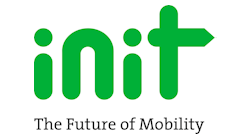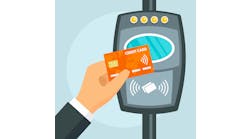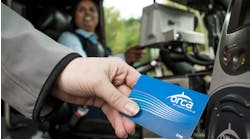Vancouver, Wash.
Katie Nelson
Project Manager
C-TRAN
When Hop Fastpass officially launched in July 2017, it marked a milestone for public transportation in the Portland-Vancouver region. Hop introduced a state-of-the-art electronic fare system and represented a big change for transit riders in the area. It also culminated a years-long planning process for three agencies simultaneously rolling out the same product — but doing so for different customer groups with different needs.
Hop Fastpass is a regional fare program now used by C-TRAN, TriMet and the Portland Streetcar. It allows riders to seamlessly travel between systems with the same pre-loaded transit card. It offers a host of new features that include free transfers, added security and pay-as-you-go passes that automatically stop charging the rider when certain caps are met.
C-TRAN was involved throughout the planning process, but played a secondary role in the project’s overall direction and schedule. TriMet is by far the largest transit system of the three. It was the lead agency on the project, and took on the lion’s share of the $36 million project cost, and virtually all of the liability. TriMet was the primary agency on the project because without TriMet, there would be no Hop Fastpass. Part of C-TRAN’s role was to stay on top of the process and make sure our needs — and our riders’ — were addressed. Implementing a project of this scope involves countless details. For C-TRAN, it also means making sure details of particular interest to us aren’t overlooked.
In the lead-up to the official launch, one challenge was communication to our customers. C-TRAN has a very different fare structure than TriMet. (C-TRAN has three types of fares; TriMet has one.) As a result, C-TRAN made extra efforts to adapt and create our own materials to make sure our riders’ questions were answered. This was particularly important on the question of monthly capping, with many customers wondering how caps would apply to riders who use multiple fare types in a given month. Few of the shared materials addressed these and other C-TRAN-specific questions.
Implementation created challenges of its own. Network issues affecting the system, while rare, can’t always be addressed by C-TRAN. We play a support role, but remain largely dependent on TriMet or a third party. TriMet also manages the Hop system’s back end, though C-TRAN does have limited access for certain data and reports.
C-TRAN’s involvement in the Hop Fastpass project, while challenging at times, has delivered a tremendous benefit for our agency and our riders. We’re now a part of a regional electronic fare system that has modernized our fare collection in a way that C-TRAN would not have been able to achieve on its own. And we received this long-term gain with relatively minimal financial investment from C-TRAN. Any technology project requires a certain degree of flexibility, and all three agencies showed it throughout the project. TriMet’s project manager worked to remove barriers for the project to move forward. He and all the project partners deserve credit for implementing an extremely complex system that now benefits the entire region.
Katie Nelson can be reached at [email protected], 360.906.7460 or via LinkedIn at linkedin.com/in/katie-nelson-pmp-36398279
Dallas, Texas
David Leininger
Executive Vice President, Chief Financial Officer
Dallas Area Rapid Transit
When considering mobile payment, the list of questions and answers can go on for an extended period. Before setting about to procure and deploy a mobile ticketing and payment system, it is first necessary to determine why you really want to do so and what you anticipate gaining out of the newly deployed payment capability. Otherwise, in the parlance of the young millennials, you just get a hot mess.
Some of the questions you need to consider:
Does a public transit agency really need to offer a mobile ticketing and payment option? Of course it does.
Is there a logical limit to the size of the agency that would benefit from a mobile ticketing and payment offering? No, not really.
Is it a cost-effective, affordable option, even for a small agency? Yes, unless you cut a poor deal with the vendor.
Can I develop the capability in-house? Yes, but it will never be as feature-rich as third-party solutions and most likely will not be able to keep up with the new version releases of the mobile phone operating systems.
Can the agency begin with a pilot and then launch a full deployment later? Yes, but the agency risks going through two procurement exercises versus one. Further, it cannot assure the vendor participating in the pilot will be the successful bidder in the full deployment.
Should the agency limit the products available for purchase to special events and periods of time versus putting the full range of product types on the app? No. While a limited array of products can be the approach, it reduces the benefit of the mobile offering functionality to the rider, forcing the rider to use multiple methods when one would suffice, it still requires roughly the same amount of staff support and significantly reduces the transactions over which the capital investment can be amortized.
The basic rationale for including mobile ticketing and payment functionality in a public transit system’s payment options should be obvious: The vast majority of riders now carry a smartphone — even more so among lower income demographics. Purchasing tickets via mobile phones is far easier and less time consuming than using a ticket vending machines, it can combine trip planning, ticket purchase and payment into one app and it provides value-added benefits to the customer and reduces customer frustration. In addition, capital costs for fareboxes and ticket vending machines are reduced, and in some cases, eliminated because the agency shifts these costs to the rider’s smartphone.
The data accumulation and analysis benefits derived from a robust deployment of mobile are also significant. Information regarding the types of mobile phones and operating systems in use, the percentage preferences for such by the riders, the types and times of products purchased and the time of activation and the patterns of purchase for individual users generates a great deal of useful information regarding customer preferences and patterns.
The emerging benefit of considerable significance is the nexus a mobile ticketing and payment platform provides with many of the new transportation network companies and specialty transportation services, such as Uber, Lyft, taxi, micro-transit, dynamic carpooling and even public agency equivalent services to the TNCs. In addition, the mobile platform permits relatively straightforward integration with payment networks, cash-to-mobile storage value applications and a broad range of digital entertainment proof-of-purchase products, including general admission tickets or coupons.
The way forward in public transportation will be integrated mobility as a service (MaaS) solutions in which a mixed-mode journey is seamlessly requested and billed in a single bundled price to the rider with settlement to participating providers in the backend. The mobile platform is the portal to that solution.
So, how to get started?
The most effective thing an agency can do is to prepare a concept of operations (COO) document, which describes in 20 to 30 pages how the mobile ticketing solution is intended to work, in words and exhibits intended to be clearly understood by operators, fare enforcement personnel, IT staff, finance and revenue staff, fare equipment technicians, marketing and customer service staff, and procurement staff. It is definitely not a technical specification, but rather a clear narrative discussion of what the concept is and how it should work. This is a document best written by in-house staff, not a consultant. Done properly, the document — and the exercise which supported its development — will give the agency team confidence they understand what they really want to achieve and how they really want it to function.
From that point forward the normal agency procurement processes will inevitably have to be engaged. The COO will serve to provide the scope description, establish metrics for performance and identify and define the key contributors required to prepare a request for proposal for the design, deployment and support of the mobile ticketing initiative. Fortunately at this point in time, there are a number of good mobile ticketing vendors available and a sufficient number of agencies who have already deployed mobile ticketing solutions and are more than willing to share their experiences.
Mobile ticketing and payment solutions should be part of every public transit agency’s fare payment platform. Done reasonably well, this is the kind of quote you should be able to obtain from your local media outlet: “This is the DART app that everyone should have on their phone … I find the GoPass app to be as useful as a TollTag. It makes your life a lot easier even if you don't use it every day,” "Dallas Morning News," Personal Technology, Sunday, December 28, 2017. https://www.dallasnews.com/business/technology/2017/12/28/new-phone-tablet-christmas-apps-try
DART’s COO is available to other agency staff upon request be contacting Leininger at DART, P.O. Box 660163, Dallas, TX 75266-7220 or [email protected].
Hear more from David and Katie during a free webinar, February 15, 2:00 CST. Register at https://event.webcasts.com/starthere.jsp?ei=1179550&tp_key=e4569fc963
After the live event, the presentation will be available for viewing at http://www.masstransitmag.com/webinars.



